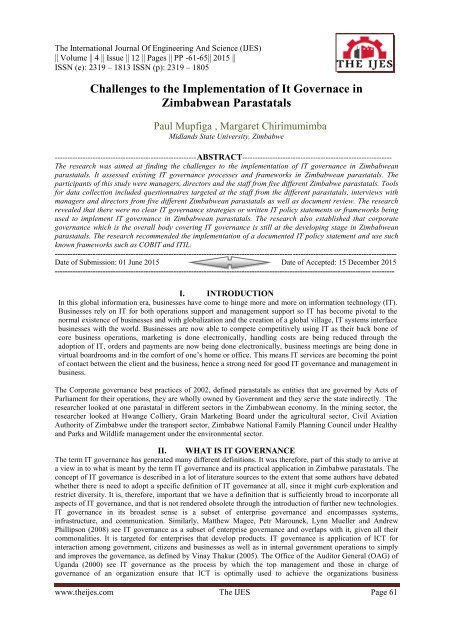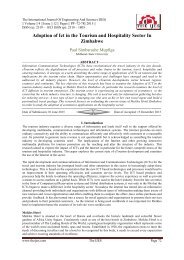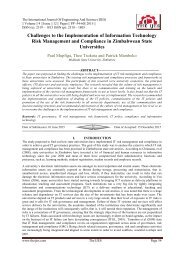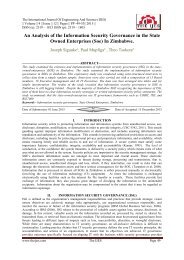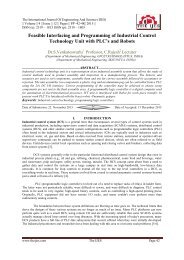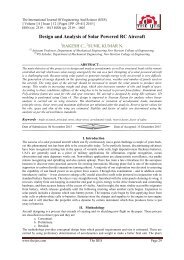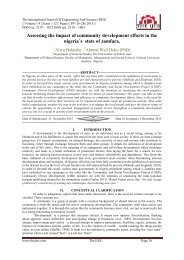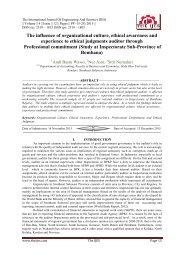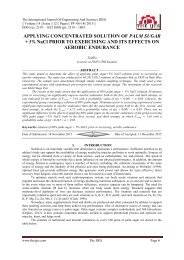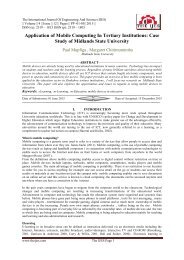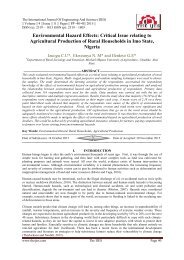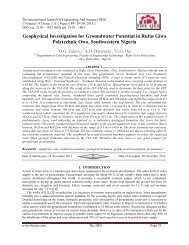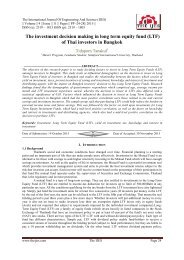Challenges to the Implementation of It Governace in Zimbabwean Parastatals
The International Journal of Engineering & Science is aimed at providing a platform for researchers, engineers, scientists, or educators to publish their original research results, to exchange new ideas, to disseminate information in innovative designs, engineering experiences and technological skills. It is also the Journal's objective to promote engineering and technology education. All papers submitted to the Journal will be blind peer-reviewed. Only original articles will be published.
The International Journal of Engineering & Science is aimed at providing a platform for researchers, engineers, scientists, or educators to publish their original research results, to exchange new ideas, to disseminate information in innovative designs, engineering experiences and technological skills. It is also the Journal's objective to promote engineering and technology education. All papers submitted to the Journal will be blind peer-reviewed. Only original articles will be published.
Create successful ePaper yourself
Turn your PDF publications into a flip-book with our unique Google optimized e-Paper software.
The International Journal Of Eng<strong>in</strong>eer<strong>in</strong>g And Science (IJES)<br />
|| Volume || 4 || Issue || 12 || Pages || PP -61-65|| 2015 ||<br />
ISSN (e): 2319 – 1813 ISSN (p): 2319 – 1805<br />
<strong>Challenges</strong> <strong>to</strong> <strong>the</strong> <strong>Implementation</strong> <strong>of</strong> <strong>It</strong> <strong>Governace</strong> <strong>in</strong><br />
<strong>Zimbabwean</strong> <strong>Parastatals</strong><br />
Paul Mupfiga , Margaret Chirimumimba<br />
Midlands State University, Zimbabwe<br />
--------------------------------------------------------ABSTRACT-----------------------------------------------------------<br />
The research was aimed at f<strong>in</strong>d<strong>in</strong>g <strong>the</strong> challenges <strong>to</strong> <strong>the</strong> implementation <strong>of</strong> IT governance <strong>in</strong> <strong>Zimbabwean</strong><br />
parastatals. <strong>It</strong> assessed exist<strong>in</strong>g IT governance processes and frameworks <strong>in</strong> <strong>Zimbabwean</strong> parastatals. The<br />
participants <strong>of</strong> this study were managers, direc<strong>to</strong>rs and <strong>the</strong> staff from five different Zimbabwe parastatals. Tools<br />
for data collection <strong>in</strong>cluded questionnaires targeted at <strong>the</strong> staff from <strong>the</strong> different parastatals, <strong>in</strong>terviews with<br />
managers and direc<strong>to</strong>rs from five different <strong>Zimbabwean</strong> parastatals as well as document review. The research<br />
revealed that <strong>the</strong>re were no clear IT governance strategies or written IT policy statements or frameworks be<strong>in</strong>g<br />
used <strong>to</strong> implement IT governance <strong>in</strong> <strong>Zimbabwean</strong> parastatals. The research also established that corporate<br />
governance which is <strong>the</strong> overall body cover<strong>in</strong>g IT governance is still at <strong>the</strong> develop<strong>in</strong>g stage <strong>in</strong> <strong>Zimbabwean</strong><br />
parastatals. The research recommended <strong>the</strong> implementation <strong>of</strong> a documented IT policy statement and use such<br />
known frameworks such as COBIT and ITIL.<br />
---------------------------------------------------------------------------------------------------------------------------------------<br />
Date <strong>of</strong> Submission: 01 June 2015 Date <strong>of</strong> Accepted: 15 December 2015<br />
----------------------------------------------------------------------------------------------------------------------------- ---------<br />
I. INTRODUCTION<br />
In this global <strong>in</strong>formation era, bus<strong>in</strong>esses have come <strong>to</strong> h<strong>in</strong>ge more and more on <strong>in</strong>formation technology (IT).<br />
Bus<strong>in</strong>esses rely on IT for both operations support and management support so IT has become pivotal <strong>to</strong> <strong>the</strong><br />
normal existence <strong>of</strong> bus<strong>in</strong>esses and with globalization and <strong>the</strong> creation <strong>of</strong> a global village, IT systems <strong>in</strong>terface<br />
bus<strong>in</strong>esses with <strong>the</strong> world. Bus<strong>in</strong>esses are now able <strong>to</strong> compete competitively us<strong>in</strong>g IT as <strong>the</strong>ir back bone <strong>of</strong><br />
core bus<strong>in</strong>ess operations, market<strong>in</strong>g is done electronically, handl<strong>in</strong>g costs are be<strong>in</strong>g reduced through <strong>the</strong><br />
adoption <strong>of</strong> IT, orders and payments are now be<strong>in</strong>g done electronically, bus<strong>in</strong>ess meet<strong>in</strong>gs are be<strong>in</strong>g done <strong>in</strong><br />
virtual boardrooms and <strong>in</strong> <strong>the</strong> comfort <strong>of</strong> one‟s home or <strong>of</strong>fice. This means IT services are becom<strong>in</strong>g <strong>the</strong> po<strong>in</strong>t<br />
<strong>of</strong> contact between <strong>the</strong> client and <strong>the</strong> bus<strong>in</strong>ess, hence a strong need for good IT governance and management <strong>in</strong><br />
bus<strong>in</strong>ess.<br />
The Corporate governance best practices <strong>of</strong> 2002, def<strong>in</strong>ed parastatals as entities that are governed by Acts <strong>of</strong><br />
Parliament for <strong>the</strong>ir operations, <strong>the</strong>y are wholly owned by Government and <strong>the</strong>y serve <strong>the</strong> state <strong>in</strong>directly. The<br />
researcher looked at one parastatal <strong>in</strong> different sec<strong>to</strong>rs <strong>in</strong> <strong>the</strong> <strong>Zimbabwean</strong> economy. In <strong>the</strong> m<strong>in</strong><strong>in</strong>g sec<strong>to</strong>r, <strong>the</strong><br />
researcher looked at Hwange Colliery, Gra<strong>in</strong> Market<strong>in</strong>g Board under <strong>the</strong> agricultural sec<strong>to</strong>r, Civil Aviation<br />
Authority <strong>of</strong> Zimbabwe under <strong>the</strong> transport sec<strong>to</strong>r, Zimbabwe National Family Plann<strong>in</strong>g Council under Healthy<br />
and Parks and Wildlife management under <strong>the</strong> environmental sec<strong>to</strong>r.<br />
II. WHAT IS IT GOVERNANCE<br />
The term IT governance has generated many different def<strong>in</strong>itions. <strong>It</strong> was <strong>the</strong>refore, part <strong>of</strong> this study <strong>to</strong> arrive at<br />
a view <strong>in</strong> <strong>to</strong> what is meant by <strong>the</strong> term IT governance and its practical application <strong>in</strong> Zimbabwe parastatals. The<br />
concept <strong>of</strong> IT governance is described <strong>in</strong> a lot <strong>of</strong> literature sources <strong>to</strong> <strong>the</strong> extent that some authors have debated<br />
whe<strong>the</strong>r <strong>the</strong>re is need <strong>to</strong> adopt a specific def<strong>in</strong>ition <strong>of</strong> IT governance at all, s<strong>in</strong>ce it might curb exploration and<br />
restrict diversity. <strong>It</strong> is, <strong>the</strong>refore, important that we have a def<strong>in</strong>ition that is sufficiently broad <strong>to</strong> <strong>in</strong>corporate all<br />
aspects <strong>of</strong> IT governance, and that is not rendered obsolete through <strong>the</strong> <strong>in</strong>troduction <strong>of</strong> fur<strong>the</strong>r new technologies.<br />
IT governance <strong>in</strong> its broadest sense is a subset <strong>of</strong> enterprise governance and encompasses systems,<br />
<strong>in</strong>frastructure, and communication. Similarly, Mat<strong>the</strong>w Magee, Petr Marounek, Lynn Mueller and Andrew<br />
Phillipson (2008) see IT governance as a subset <strong>of</strong> enterprise governance and overlaps with it, given all <strong>the</strong>ir<br />
commonalities. <strong>It</strong> is targeted for enterprises that develop products. IT governance is application <strong>of</strong> ICT for<br />
<strong>in</strong>teraction among government, citizens and bus<strong>in</strong>esses as well as <strong>in</strong> <strong>in</strong>ternal government operations <strong>to</strong> simply<br />
and improves <strong>the</strong> governance, as def<strong>in</strong>ed by V<strong>in</strong>ay Thakur (2005). The Office <strong>of</strong> <strong>the</strong> Audi<strong>to</strong>r General (OAG) <strong>of</strong><br />
Uganda (2000) see IT governance as <strong>the</strong> process by which <strong>the</strong> <strong>to</strong>p management and those <strong>in</strong> charge <strong>of</strong><br />
governance <strong>of</strong> an organization ensure that ICT is optimally used <strong>to</strong> achieve <strong>the</strong> organizations bus<strong>in</strong>ess<br />
www.<strong>the</strong>ijes.com The IJES Page 61
<strong>Challenges</strong> To The <strong>Implementation</strong> Of <strong>It</strong> <strong>Governace</strong> In…<br />
objectives. At <strong>the</strong> same time <strong>the</strong> risk aris<strong>in</strong>g from <strong>the</strong> use <strong>of</strong> IT are also properly managed. Accord<strong>in</strong>g <strong>to</strong> Richard<br />
Brisebois, Greg Boyd and Ziad Shadid (2010) IT governance is <strong>the</strong> structure, oversight and management<br />
processes which ensure <strong>the</strong> delivery <strong>of</strong> <strong>the</strong> expected benefits <strong>of</strong> IT <strong>in</strong> a controlled way <strong>to</strong> help enhance <strong>the</strong> long<br />
term susta<strong>in</strong>able success <strong>of</strong> <strong>the</strong> enterprise. Challis, Lidgey and Robertson (2003) see‟s IT governance is <strong>the</strong><br />
responsibility <strong>of</strong> <strong>the</strong> board <strong>of</strong> direc<strong>to</strong>rs and executive management. <strong>It</strong> is an <strong>in</strong>tegral part <strong>of</strong> enterprise governance<br />
and consists <strong>of</strong> <strong>the</strong> leadership and organisational structures and processes that ensure that <strong>the</strong> organisation‟s IT<br />
susta<strong>in</strong>s and extends <strong>the</strong> organisation‟s strategies and objectives. In order <strong>to</strong> delimit <strong>the</strong> scope <strong>of</strong> this research,<br />
for it <strong>to</strong> be sufficiently focused, adopted. Carry and Willis (2001) def<strong>in</strong>es IT governance as <strong>the</strong> structure <strong>of</strong><br />
relationships and processes <strong>to</strong> direct and control <strong>the</strong> enterprise <strong>in</strong> order <strong>to</strong> achieve <strong>the</strong> enterprise‟s goals by<br />
add<strong>in</strong>g value while balanc<strong>in</strong>g risk versus return over IT and its processes. <strong>It</strong> specifies <strong>the</strong> decision rights and<br />
accountability framework <strong>to</strong> encourage desirable behaviours <strong>in</strong> <strong>the</strong> use <strong>of</strong> IT. The basis <strong>of</strong> <strong>the</strong>se def<strong>in</strong>itions <strong>of</strong> IT<br />
governance are a comb<strong>in</strong>ation, <strong>of</strong> implementation and relationship <strong>of</strong> <strong>the</strong> activities for manag<strong>in</strong>g IT resources<br />
and <strong>the</strong>ir risks <strong>in</strong> different ways and whe<strong>the</strong>r it is at strategic level, management level or operational level. The<br />
def<strong>in</strong>itions cited above are potentially relevant <strong>to</strong> <strong>the</strong> range <strong>of</strong> IT governance activities carried out <strong>in</strong> Zimbabwe<br />
parastatals.<br />
III. WHY IT GOVERNANCE IS NECESSARY<br />
Accord<strong>in</strong>g <strong>to</strong> Richard Brisebois, Greg Boyd and Ziad Shadid <strong>of</strong> <strong>the</strong> Office <strong>of</strong> <strong>the</strong> Audi<strong>to</strong>r General <strong>of</strong> Canada, IT<br />
governance is needed <strong>to</strong> ensure that <strong>the</strong> <strong>in</strong>vestments <strong>in</strong> IT generate value-reward-and mitigate IT-associated<br />
risks, avoid<strong>in</strong>g failure. IT is central <strong>to</strong> organisational success – effective and efficient delivery <strong>of</strong> services and<br />
goods – especially when <strong>the</strong> IT is designed <strong>to</strong> br<strong>in</strong>g about change <strong>in</strong> an organisation. This change process,<br />
commonly referred <strong>to</strong> as “bus<strong>in</strong>ess transformation,” is now <strong>the</strong> prime enabler <strong>of</strong> new bus<strong>in</strong>ess models both <strong>in</strong><br />
<strong>the</strong> private and public sec<strong>to</strong>rs. Bus<strong>in</strong>ess transformation <strong>of</strong>fers many rewards, but it also has <strong>the</strong> potential for<br />
many risks, which may disrupt operations and have un<strong>in</strong>tended consequences. The dilemma becomes how <strong>to</strong><br />
balance risk and rewards when us<strong>in</strong>g IT <strong>to</strong> enable organisational change.<br />
PROBLEMS WITH IT GOVERNANCE<br />
Accord<strong>in</strong>g <strong>to</strong> Steve Romero, an IT Governance Evangelist, <strong>the</strong> problem with IT governance is that <strong>of</strong>ten it is<br />
confused with good management practices and IT control frameworks. ISO 38500 has helped clarify IT<br />
governance by describ<strong>in</strong>g it as <strong>the</strong> management system used by direc<strong>to</strong>rs. In o<strong>the</strong>r words, IT governance is about<br />
<strong>the</strong> stewardship <strong>of</strong> IT resources on behalf <strong>of</strong> <strong>the</strong> stakeholders who expect a return from <strong>the</strong>ir <strong>in</strong>vestment. The<br />
direc<strong>to</strong>rs responsible for this stewardship will look <strong>to</strong> <strong>the</strong> management <strong>to</strong> implement <strong>the</strong> necessary systems and<br />
IT controls. Whilst manag<strong>in</strong>g risk and ensur<strong>in</strong>g compliance are essential components <strong>of</strong> good governance, it is<br />
more important <strong>to</strong> be focused on deliver<strong>in</strong>g value and measur<strong>in</strong>g performance.<br />
IV. RESEARCH METHODOLOGY<br />
This study attempted <strong>to</strong> estimate <strong>the</strong> current level <strong>of</strong> practice <strong>of</strong> IT governance <strong>in</strong> Zimbabwe parastatals. The<br />
study allowed <strong>the</strong> collection <strong>of</strong> useful <strong>in</strong>formation and data <strong>in</strong> relation <strong>to</strong> this new mode <strong>of</strong> governance. The<br />
considerations are based on questionnaire responses from 40 employees from five different Zimbabwe<br />
parastatals, who were randomly selected, Skype <strong>in</strong>terviews with five managers and direc<strong>to</strong>rs from <strong>the</strong>se five<br />
different parastatals and document review. The questionnaire was designed <strong>to</strong> collect data on <strong>the</strong>ir level <strong>of</strong><br />
computer expertise, <strong>the</strong>ir awareness on IT governance and <strong>the</strong>ir level <strong>of</strong> preparedness <strong>to</strong> adopt IT governance.<br />
The questionnaire had both closed and open end questions. The questionnaire was adm<strong>in</strong>istered <strong>in</strong> person <strong>to</strong> <strong>the</strong><br />
40 employees from <strong>the</strong> five different Zimbabwe parastatals. Skype <strong>in</strong>terviews with <strong>the</strong> five managers and<br />
direc<strong>to</strong>rs from <strong>the</strong>se five different parastatals were contacted <strong>to</strong> highlight <strong>the</strong> benefits and <strong>the</strong> exploitation <strong>of</strong> <strong>the</strong><br />
challenges <strong>to</strong> implement<strong>in</strong>g IT governance <strong>in</strong> Zimbabwe parastatals. The researcher reviewed from newspaper<br />
articles, strategy documents, newsletters, magaz<strong>in</strong>es, <strong>in</strong>formation from M<strong>in</strong>ister Gordon Moyo‟s blog and<br />
various parastatals websites.<br />
IT Infrastructure: hardware and s<strong>of</strong>tware<br />
The data collected from <strong>the</strong> five different parastatals shows tremendous developments and acquisition <strong>of</strong> basic<br />
IT <strong>in</strong>frastructure across <strong>the</strong> various parastatals. 79% <strong>of</strong> <strong>the</strong> employees <strong>in</strong>dicated that <strong>the</strong>y had access <strong>to</strong><br />
computers <strong>in</strong> <strong>the</strong>ir <strong>of</strong>fices hence enabl<strong>in</strong>g <strong>the</strong>m <strong>to</strong> access and utilize IT facilities for <strong>the</strong>ir day <strong>to</strong> day bus<strong>in</strong>ess<br />
operations. Fifty-n<strong>in</strong>e percent (59%) <strong>of</strong> <strong>the</strong> employees <strong>in</strong>dicated that some <strong>of</strong> <strong>the</strong>ir clients use POS devices and<br />
mobile money transfer systems <strong>to</strong> make utility payments. An amaz<strong>in</strong>g number <strong>of</strong> employees, (88%), <strong>in</strong>dicated<br />
that <strong>the</strong>y access <strong>the</strong> Zimbabwe parastatals‟ website and <strong>the</strong> M<strong>in</strong>ister <strong>of</strong> state enterprises‟ onl<strong>in</strong>e blog easily, at<br />
least once a day for various reasons but ma<strong>in</strong>ly for communication. As regards <strong>to</strong> s<strong>of</strong>tware, results show that<br />
various Zimbabwe parastatals have developed <strong>the</strong>ir own <strong>in</strong>-house transaction process<strong>in</strong>g systems,<br />
communication <strong>in</strong>formation systems and management <strong>in</strong>formation system s<strong>of</strong>tware used across <strong>the</strong>se various<br />
www.<strong>the</strong>ijes.com The IJES Page 62
<strong>Challenges</strong> To The <strong>Implementation</strong> Of <strong>It</strong> <strong>Governace</strong> In…<br />
parastatals. Some parastatals are now <strong>of</strong>fer<strong>in</strong>g <strong>the</strong>ir clients access <strong>to</strong> onl<strong>in</strong>e cus<strong>to</strong>mer service support, equerries<br />
and utility bill payment facilities.<br />
The level <strong>of</strong> IT governance practice and activities<br />
The data collected <strong>in</strong>dicate that <strong>the</strong>re is reasonable utilization <strong>of</strong> IT resources <strong>in</strong> as far as <strong>the</strong> parastatals‟ core<br />
daily bus<strong>in</strong>ess activities are concerned. Only 53% <strong>of</strong> <strong>the</strong> employees <strong>in</strong>dicated that <strong>the</strong>y were us<strong>in</strong>g all <strong>the</strong> IT<br />
resources, facilities and services <strong>of</strong>fered by <strong>the</strong> parastatals <strong>in</strong> carry<strong>in</strong>g out <strong>the</strong>ir day <strong>to</strong> day duties and tasks.<br />
Interviews with <strong>the</strong> managers and direc<strong>to</strong>rs revealed that all <strong>the</strong> parastatals have an IT manager responsible for<br />
manag<strong>in</strong>g all IT resources f<strong>in</strong>ancially, materially and as well as <strong>to</strong> oversee <strong>the</strong> implementation <strong>of</strong> <strong>the</strong> <strong>to</strong>p<br />
management‟s IT goals and targets at operational level with<strong>in</strong> his/her organisation. Most IT resources and<br />
facilities are exclusive <strong>to</strong> all parastatals employees as part <strong>of</strong> <strong>the</strong>ir work environment. The parastatals‟ clients<br />
have access <strong>to</strong> some <strong>of</strong> <strong>the</strong>se facilities and can enjoy <strong>the</strong>m at various levels for no extra charge. The day <strong>to</strong> day<br />
bus<strong>in</strong>ess operations have become more <strong>in</strong>teractive through <strong>the</strong> use <strong>of</strong> website l<strong>in</strong>ks with <strong>in</strong>teractive <strong>to</strong>ols like <strong>the</strong><br />
M<strong>in</strong>ister‟s onl<strong>in</strong>e blog, staff discussion forums, emails, <strong>in</strong>stant chats, chat rooms and o<strong>the</strong>r <strong>in</strong>teractive activities.<br />
The daily bus<strong>in</strong>ess activities carried out through <strong>the</strong> use <strong>of</strong> IT reflect its use as a support <strong>to</strong>ol <strong>to</strong> <strong>the</strong> traditional<br />
face <strong>to</strong> face bus<strong>in</strong>ess methods, thus a need for its governance and management across <strong>the</strong> parastatals.<br />
Employee’s preparedness<br />
The collected data show that <strong>the</strong> majority <strong>of</strong> employees have a satisfac<strong>to</strong>ry level <strong>of</strong> computer competency.<br />
Sixty-eight percent (68%) <strong>of</strong> <strong>the</strong> employees <strong>in</strong>dicated that <strong>the</strong>y could perform basic functions and could use <strong>the</strong><br />
computer <strong>in</strong>dependently. A fur<strong>the</strong>r 29% <strong>of</strong> <strong>the</strong> employees <strong>in</strong>dicated that <strong>the</strong>y were advanced users <strong>of</strong> computers<br />
and could do a number <strong>of</strong> tasks with <strong>the</strong> computer. As regards <strong>to</strong> <strong>the</strong> use <strong>of</strong> <strong>the</strong> Internet, <strong>the</strong> majority <strong>of</strong> <strong>the</strong><br />
employees (95%) <strong>in</strong>dicated that <strong>the</strong>y were advanced users who could use <strong>the</strong> Internet <strong>to</strong> search for <strong>in</strong>formation<br />
as well as be<strong>in</strong>g able <strong>to</strong> download and upload files on <strong>to</strong> <strong>the</strong> Internet. Fifty-one percent (51%) <strong>in</strong>dicated that <strong>the</strong>y<br />
had basic skills required <strong>to</strong> browse <strong>the</strong> <strong>in</strong>ternet and use e-mail <strong>in</strong>dependently and a disappo<strong>in</strong>t<strong>in</strong>g 5% <strong>in</strong>dicated<br />
that <strong>the</strong>y could not use <strong>the</strong> Internet <strong>in</strong>dependently. Although <strong>the</strong> majority <strong>of</strong> <strong>the</strong> employees <strong>in</strong>dicated that <strong>the</strong>y<br />
had <strong>the</strong> basic skills required <strong>to</strong> use computers as a day <strong>to</strong> day bus<strong>in</strong>ess resource, a significant number <strong>of</strong> <strong>the</strong>m<br />
lacked confidence <strong>in</strong> <strong>the</strong> use <strong>of</strong> <strong>the</strong> transaction process<strong>in</strong>g system platforms and how <strong>to</strong> participate on <strong>the</strong><br />
M<strong>in</strong>ister‟s blog.8% <strong>of</strong> <strong>the</strong> employees expressed some doubt on <strong>the</strong>ir level <strong>of</strong> preparedness <strong>to</strong> use transaction<br />
process<strong>in</strong>g platforms, <strong>the</strong> parastatals website and <strong>the</strong> M<strong>in</strong>ister‟s blog.<br />
Absence <strong>of</strong> documented strategy<br />
The implementation <strong>of</strong> IT governance <strong>in</strong> Zimbabwe parastatals is prov<strong>in</strong>g <strong>to</strong> be slow and lagg<strong>in</strong>g beh<strong>in</strong>d, this<br />
was noted by <strong>the</strong> lack <strong>of</strong> clear IT governance strategies, written IT policy statements and frameworks be<strong>in</strong>g used<br />
<strong>to</strong> implement IT governance. The parastatals are <strong>in</strong>terested <strong>in</strong> improv<strong>in</strong>g <strong>in</strong> <strong>the</strong>ir IT usage and but little has been<br />
on <strong>the</strong> governance <strong>of</strong> <strong>the</strong> IT resources. The proposed corporate governance framework for parastatals, does not<br />
say not much perta<strong>in</strong><strong>in</strong>g I.T governance.<br />
Project ownership by bus<strong>in</strong>ess<br />
Based on <strong>the</strong> f<strong>in</strong>d<strong>in</strong>gs <strong>of</strong> this research most <strong>of</strong> <strong>the</strong> managers and direc<strong>to</strong>rs who were <strong>in</strong>terviewed were ei<strong>the</strong>r<br />
bitterly critical or derisive about <strong>the</strong> contribution <strong>of</strong> IT <strong>to</strong> <strong>the</strong> bus<strong>in</strong>ess, <strong>the</strong>re was a near absence <strong>of</strong> ownership <strong>of</strong><br />
IT projects. Bus<strong>in</strong>ess looked upon IT as <strong>to</strong>o technical <strong>to</strong> handle and reta<strong>in</strong>ed only <strong>the</strong> right <strong>to</strong> criticize IT for<br />
non-delivery.<br />
S<strong>of</strong>tware documentation<br />
All <strong>the</strong>se parastatals are us<strong>in</strong>g pirated s<strong>of</strong>tware so <strong>the</strong>y do not have licences for <strong>the</strong>se s<strong>of</strong>twares .The core<br />
systems at Civil Aviation Authority <strong>of</strong> Zimbabwe was obta<strong>in</strong>ed with source code but has s<strong>in</strong>ce undergone<br />
several changes over <strong>the</strong> last six years with no attendant documentation.<br />
V. DISCUSSION<br />
From <strong>the</strong> f<strong>in</strong>d<strong>in</strong>gs <strong>of</strong> this research, <strong>the</strong> researcher noted that <strong>the</strong> major challenge <strong>to</strong> <strong>the</strong> implementation <strong>of</strong> IT<br />
governance <strong>in</strong> parastatals is that corporate governance is a rot and was still at a develop<strong>in</strong>g stage. The bus<strong>in</strong>ess<br />
ethics <strong>in</strong> some <strong>of</strong> <strong>the</strong>se State Enterprise and <strong>Parastatals</strong> leaves a lot <strong>to</strong> be desired especially where most <strong>of</strong> <strong>the</strong><br />
board members and even chief executive <strong>of</strong>ficers are <strong>in</strong>volved <strong>in</strong> scandalous issues. Bus<strong>in</strong>ess analysts <strong>in</strong><br />
Zimbabwe have raised concern over bus<strong>in</strong>ess people who sit on several boards purport<strong>in</strong>g <strong>to</strong> serve <strong>the</strong> <strong>in</strong>terests<br />
<strong>of</strong> those companies when <strong>in</strong> actual fact, <strong>the</strong>y have ulterior motives ma<strong>in</strong>ly <strong>to</strong> enrich <strong>the</strong>mselves ra<strong>the</strong>r than <strong>to</strong><br />
practice good corporate governance. Notable bus<strong>in</strong>ess people and civic leaders are sitt<strong>in</strong>g on several boards yet<br />
hold<strong>in</strong>g public <strong>of</strong>fice. Analysts say <strong>in</strong> most cases, it reflects poor corporate governance due <strong>to</strong> serious conflict <strong>of</strong><br />
<strong>in</strong>terests. Good corporate governance practices have been implemented <strong>to</strong> a limited extent and <strong>the</strong> major barriers<br />
www.<strong>the</strong>ijes.com The IJES Page 63
<strong>Challenges</strong> To The <strong>Implementation</strong> Of <strong>It</strong> <strong>Governace</strong> In…<br />
be<strong>in</strong>g, corruption which has become a culture among <strong>Zimbabwean</strong>s, reported <strong>the</strong> herald <strong>of</strong> 28 August 2012.<br />
Direc<strong>to</strong>rs and company <strong>of</strong>ficials were engaged <strong>in</strong> conduct that is not <strong>in</strong> <strong>the</strong> general <strong>in</strong>terest <strong>of</strong> <strong>the</strong> company but<br />
merely <strong>to</strong> satisfy <strong>the</strong>ir own personal needs. Accord<strong>in</strong>g <strong>to</strong> <strong>the</strong> herald <strong>of</strong> 28August 2012 <strong>in</strong> Zimbabwe Boards <strong>of</strong><br />
direc<strong>to</strong>rs are sometimes selected on <strong>the</strong> basis <strong>of</strong> who knows who, termed <strong>the</strong> „Old Boys Club‟ and that<br />
negatively impacts on <strong>the</strong> effectiveness <strong>of</strong> <strong>the</strong> board. Board selection is critical as <strong>the</strong>re are specific criteria that<br />
need <strong>to</strong> be employed <strong>to</strong> ensure <strong>the</strong> right board mix. Such an environment compromises <strong>the</strong> <strong>in</strong>dependence <strong>of</strong><br />
non-executive direc<strong>to</strong>rs, as a result, <strong>in</strong>dependent <strong>in</strong>ternational civic organisations such as Transparency<br />
International, rates Zimbabwe as one <strong>of</strong> <strong>the</strong> most corrupt countries <strong>in</strong> <strong>the</strong> world. This means it is very important<br />
<strong>to</strong> create good corporate governance structures so as <strong>to</strong> implement IT governance successfully, s<strong>in</strong>ce IT is a<br />
subset <strong>of</strong> corporate governance.<br />
The research also established that some parastatals such as <strong>the</strong> Parks and Wildlife Management Authority <strong>of</strong><br />
Zimbabwe and Civil Aviation Authority <strong>of</strong> Zimbabwe were operat<strong>in</strong>g without boards, thus creat<strong>in</strong>g a leadership<br />
vacuum and also legal constra<strong>in</strong>ts for <strong>the</strong> validation <strong>of</strong> policy decisions and approval or authorization <strong>of</strong><br />
programmes, hence also becom<strong>in</strong>g a huge barrier <strong>to</strong> <strong>the</strong> implementation <strong>of</strong> IT governance. Parastatal boards<br />
should always be properly constituted, timeously appo<strong>in</strong>ted, and <strong>the</strong> selection process based on competency,<br />
reliability, appropriate knowledge and experience. <strong>It</strong> is worry<strong>in</strong>g for State entities <strong>to</strong> operate without boards for<br />
long periods because management are <strong>the</strong>n left <strong>to</strong> operate without accountability, a situation which may<br />
compromise <strong>the</strong> efficiency and effectiveness <strong>of</strong> an entity due ma<strong>in</strong>ly <strong>to</strong> <strong>the</strong> absence <strong>of</strong> an effective oversight<br />
function. This calls <strong>in</strong> some <strong>in</strong>stances for changes <strong>in</strong> leadership structures and renewal <strong>in</strong> <strong>Parastatals</strong> for better<br />
performance, f<strong>in</strong>ancial report<strong>in</strong>g, audit systems and good IT governance.<br />
Accord<strong>in</strong>g <strong>to</strong> <strong>the</strong> National family plann<strong>in</strong>g council CEO, Mr.Takayendesa, National family plann<strong>in</strong>g council is<br />
us<strong>in</strong>g <strong>the</strong> Control Objectives for Information and related Technology (COBIT) which is regarded as <strong>the</strong> world's<br />
lead<strong>in</strong>g IT governance and control framework for its IT governance. CobiT provides a reference model <strong>of</strong> 34 IT<br />
processes typically found <strong>in</strong> an organization. Each process is def<strong>in</strong>ed <strong>to</strong>ge<strong>the</strong>r with process <strong>in</strong>puts and outputs,<br />
key process activities, process objectives, performance measures and an elementary maturity model. <strong>It</strong>s<br />
implementation is questionable based on <strong>the</strong> state <strong>of</strong> I.T governance at this organisation.<br />
To date implementation <strong>of</strong> IT governance <strong>in</strong> Zimbabwe parastatals has been regarded a failure and IT<br />
governance has not yet revolutionalised service delivery by parastals but <strong>to</strong> a limited extent it has managed <strong>to</strong><br />
change how some services such as cash payments, utility bill payments, mobile money transfers, order<br />
process<strong>in</strong>g, transaction process<strong>in</strong>g and decision mak<strong>in</strong>g processes are be<strong>in</strong>g carried out <strong>in</strong> some parastatals.<br />
VI. RECOMMENDATIONS<br />
The researcher recommends <strong>the</strong> implementation <strong>of</strong> a common tailor made parastatals IT policy and strategy<br />
framework or use <strong>of</strong> already exist<strong>in</strong>g <strong>in</strong>ternational frameworks such as COBIT and ITIL. The government<br />
should also <strong>of</strong>fer <strong>in</strong>centives for properly governed <strong>in</strong>stitutions so as <strong>to</strong> promote good corporate governance.<br />
Legal expert, Mr Canaan Dube <strong>of</strong> Dube Manikai and Hwacha, postulated that, <strong>in</strong>stead <strong>of</strong> merely forc<strong>in</strong>g listed<br />
public companies <strong>to</strong> comply with corporate governance requirements it could be helpful <strong>to</strong> create an <strong>in</strong>centive<br />
for companies <strong>to</strong> comply with corporate governance. A corporate governance rat<strong>in</strong>g could supply this<br />
motivation, as companies that scored well on <strong>the</strong> rat<strong>in</strong>g would enhance <strong>the</strong>ir reputation, and open up potential<br />
<strong>in</strong>vestment opportunities, thus, encourag<strong>in</strong>g good I.T governance practices. The Boards, risk and audit<br />
committees <strong>of</strong> <strong>the</strong> parastatals should tackle IT governance issues on a regular basis, review<strong>in</strong>g matters such as<br />
<strong>the</strong> operational aspects <strong>of</strong> <strong>in</strong>formation security and <strong>the</strong> strategic possibilities <strong>of</strong> new technologies. To improve<br />
<strong>the</strong>ir oversight <strong>of</strong> <strong>the</strong>se IT governance issues, boards should seek direc<strong>to</strong>rs with more specialized IT knowledge.<br />
VII. CONCLUSION<br />
Overly IT governance is necessary for parastatals for <strong>the</strong>ir convenience and overall well-be<strong>in</strong>g s<strong>in</strong>ce IT is now<br />
<strong>the</strong> new mode <strong>of</strong> do<strong>in</strong>g bus<strong>in</strong>ess. <strong>It</strong> is advantageous <strong>to</strong> both <strong>the</strong> national government (shareholder) and <strong>the</strong> board<br />
<strong>of</strong> direc<strong>to</strong>rs, that is, it provides an excellent structure that parastatals can follow. By implement<strong>in</strong>g ITgovernance,<br />
governments have been able <strong>to</strong> save a lot <strong>of</strong> time, money and effort which would have been<br />
o<strong>the</strong>rwise wasted on unnecessary paper work, files, and transaction costs.<br />
www.<strong>the</strong>ijes.com The IJES Page 64
<strong>Challenges</strong> To The <strong>Implementation</strong> Of <strong>It</strong> <strong>Governace</strong> In…<br />
REFERENCES<br />
[1] Ma<strong>the</strong>w Mageer (2005) Perceived E-Read<strong>in</strong>ess fac<strong>to</strong>rs <strong>in</strong> I.T governance adoption: an empirical <strong>in</strong>vestigation <strong>in</strong> a develop<strong>in</strong>g<br />
country, Vol. 3, No. 1, pp. 55-66.<br />
[2] Lynn Mueller ,Andrew Phillipson (2008)” implementation <strong>of</strong> corporate governance <strong>in</strong> Malaysian SMEs,Journal <strong>of</strong> Small<br />
Bus<strong>in</strong>ess and Enterprise Development,vol 16 Nov pp 240-255<br />
[3] Joseph McCahery and Erik (2008 )” Corporate Governance <strong>of</strong> Non Listed Companies” Oxford university press<br />
[4] Challis, Lidgey and Robertson (2003)“<strong>Implementation</strong> <strong>of</strong> I.T governance <strong>in</strong> Bangladesh: The effects <strong>of</strong>Azam, Md. Shah 2006b,<br />
“egovernance <strong>in</strong> Bangladesh: Adoption <strong>in</strong>tention and strategic options”,<br />
[5] Carry and Willis (2001) corporate governance <strong>in</strong> Bangladesh: understand<strong>in</strong>g SMEs <strong>in</strong>tention and Best, J.W. & Khan, J.V. (2004).<br />
Needham Heights, MA, USA: Allyn and Bacon.<br />
[6] Mernat Mafirakurewa (2012) <strong>Parastatals</strong> fail <strong>to</strong> submit governance reports : In bus<strong>in</strong>ess report ,Newsday ,12 Dec<br />
[7] Kuda Bwititi (2012) <strong>Parastatals</strong> operat<strong>in</strong>g without boards gordenmoyo.blogspot.com<br />
[8] The Sunday mail, 10 March<br />
[9] Gordon Moyo (2012) State <strong>of</strong> corporate governance <strong>in</strong> Zimbabwe state entreprises : Can <strong>the</strong>y be rescued ?<br />
http://gordenmoyo.blogspot.com/<br />
[10] www.mosep.gov.zw<br />
www.<strong>the</strong>ijes.com The IJES Page 65


